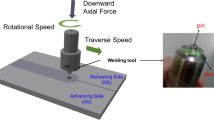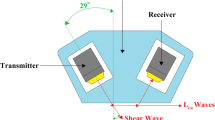Abstract
Nowadays, measuring residual stress in welded parts is of great importance in the industry. Based on the measured residual stress and the operational conditions of the part, a suitable factor of safety is defined for the design. Destructive methods have most often been used to determine residual stresses. Given limitations such as high cost, non-destructive testing (NDT) methods have replaced destructive methods in recent years. The ultrasonic method has attracted much attention in recent years for determining residual stress. In addition to its simplicity, low cost, and the need for only a few pieces of equipment, this method has additional advantages such as the ability to measure residual stress at various depths. In this paper, the feasibility of the ultrasonic method in measuring residual stress in the fusion welding of two aluminum sheets was studied and compared with the simulation result. The longitudinal residual stress was measured using the ultrasonic method via 1, 2, 4, and 5 MHz transducers at a depth near the surface. An ultrasonic wedge based on Snell’s equation was built to create the LCR wave and transmit it into the part. Next, the results obtained from the ultrasonic measurement were compared with those obtained through the numerical simulation in Abaqus software. Overall, it was found that the ultrasonic simulation method could predict with high accuracy the residual stress at various depths of the part. Furthermore, the results demonstrated that the accuracy of this method declined with an increase in the ultrasonic frequency.










Similar content being viewed by others
REFERENCES
Hu, X., Jiang, H.Y., Luo, Y., Jin, Q., Peng, W., and Yi, C.M., A study on microstructure, residual stresses and stress corrosion cracking of repair welding on 304 stainless steel: Part II-effects of reinforcement height, Materials, 2020, vol. 13, no. 11, article 2434.
Moharrami, R. and Sanayei, M., Developing a method in measuring residual stress on steel alloys by instrumented indentation technique, Measurement, 2020, vol. 158, article 107718.
Kim, J.S., Kim, M.W., and Yang, J.S., Investigation on effect of thermal aging embrittlement on residual stresses of austenitic stainless steel repair welds in nuclear components subject to seismic loads, J. Mech. Sci. Technol., 2020, vol. 34, no. 7, pp. 2821–2831.
Bayat, M., Amini, S., and Hadidi, M., Effect of ultrasonic-assisted turning on geometrical tolerances in Al 2024-T6, Mater. Manuf. Proc., 2021, vol. 23, nos. 1–2.
Rossini, N.S., Dassisti, M., Benyounis, K.Y., and Olabi, A.G., Methods of measuring residual stresses in components, Mater. Des., 2012, vol. 35, pp. 572–588.
Salvati, E. and Korsunsky, A.M., Micro-scale measurement and FEM modelling of residual stresses in AA6082-T6 Al alloy generated by wire EDM cutting, J. Mater. Proc. Technol., 2020, vol. 275, article 116373.
Murnaghan, F.D., Finite deformations of an elastic solid, Am. J. Math., 1937, vol. 59, no. 2, pp. 235–260.
Hughes, D.S. and Kelly, J.L., Second-order elastic deformation of solids, Phys. Rev., 1953, vol. 92, no. 5, article 1145.
Crecraft, D.I., The measurement of applied and residual stresses in metals using ultrasonic waves, J. Sound Vib., 1967, vol. 5, no. 1, pp. 173–192.
Egle, D.M. and Bray, D.E., Measurement of acoustoelastic and third-order elastic constants for rail steel, J. Acoust. Soc. Am., 1976, vol. 60, no. 3, pp. 741–744.
Egle, D.M. and Bray, D.E., Nondestructive Measurement of Longitudinal Rail Stresses: Application of the Acoustoelastic Effect to Rail Stress Measurement, Transp. Res. Board, 1978.
Egle, D.M. and Bray, D.E., Application of the Acoustoelastic Effect to Rail Stress Measurement. Ultrasonic Materials Characterization, Transp. Res. Board, 1980, vol. 596, no. 213.
Leon-Salamanca, T. and Bray, D.E., Ultrasonic measurement of residual stress in steels using critically refracted longitudinal waves (Lcr), PhD Dissertation, College Station: Texas A&M University, 1988.
Javadi, Y., Pirzaman, H.S., Raeisi, M.H., Najafabadi, M.A., Ultrasonic inspection of a welded stainless steel pipe to evaluate residual stresses through thickness, Mater. Des., 2013, vol. 49, pp. 591–601.
Javadi, Y., Akhlaghi, M., Najafabadi, M.A., Using finite element and ultrasonic method to evaluate welding longitudinal residual stress through the thickness in austenitic stainless steel plates, Mater. Des., 2013, vol. 45, pp. 628–642.
Javadi, Y., Salimi Pirzaman H., Hadizadeh Raeisi M., and Ahmadi Najafabadi M., Ultrasonic evaluation of welding residual stresses in stainless steel pressure vessel, J. Pressure Vessel Technol., 2013, vol. 135, no. 4.
Wentao, S.O., Bin, R.E., Wenjie, W.A., and Zhang, M., Nondestructive testing of residual stress in mechanical components based on ultrasonic LCR wave, Acad. J. Manuf. Eng., 2017, vol. 15, no. 3.
Mohammadi, M. and Fesharaki, J.J., Determination of acoustoelastic/acoustoplastic constants to measure stress in elastic/plastic limits by using LCR wave, NDT & E Int., 2019, vol. 104, pp. 69–76.
Bayat, M. and Abootorabi, M.M., Comparison of minimum quantity lubrication and wet milling based on energy consumption modeling, Proc. Inst. Mech. Eng., Part E: J. Proc. Mech. Eng., 2021, article 09544089211014407.
Vasantharaja, P., Vasudevan, M., and Palanichamy, P., Effect of welding processes on the residual stress and distortion in type 316LN stainless steel weld joints, J. Manuf. Proc., 2015, vol. 19, pp. 187–193.
AWS Standard D1.6/D1.6M. Structural welding code—Aluminum, 2003.
Author information
Authors and Affiliations
Corresponding author
Rights and permissions
About this article
Cite this article
Ali Ebrahimi, Bayat, M. & Norouzi, E. Measurement of Residual Stress Using the Ultrasonic Method in Aluminum Welding: FE Analysis and Experimental Study. Russ J Nondestruct Test 57, 669–678 (2021). https://doi.org/10.1134/S1061830921080027
Received:
Revised:
Accepted:
Published:
Issue Date:
DOI: https://doi.org/10.1134/S1061830921080027




